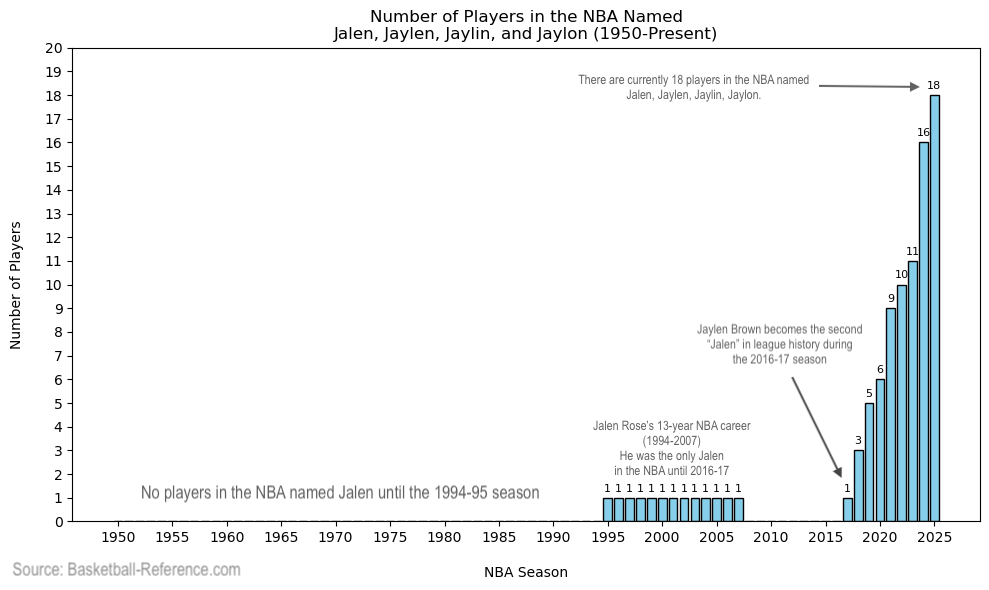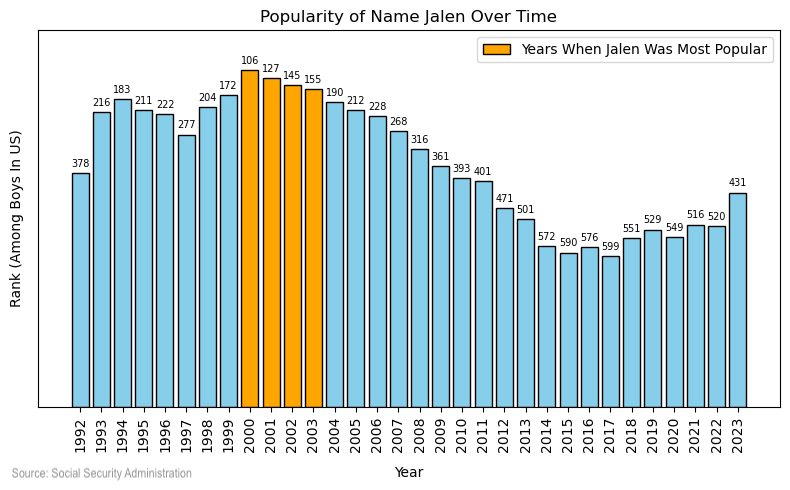If you’ve been tuning into the NBA this season, you’ve probably heard commentators call out the name “Jalen” more times than you can count. It’s like hearing “y’all” in Texas or “hella” in the San Francisco Bay Area—it’s everywhere!
That’s because Jalen has been the most common first name in the NBA for the past two seasons. According to data from basketball-reference.com, there were 13 players named Jalen in the NBA last season and there are 11 this season.1
And that’s not even the whole story. The fifth most common first name in the NBA is Jaylen—a common spelling variation of Jalen. There’s also one Jaylon (Jaylon Tyson of the Cleveland Cavaliers) and one Jaylin (Jaylin Williams2 of the Oklahoma City Thunder). Add them all up, and you’ve got 18 players with some version of the name Jalen in the NBA. Eighteen!
For context, the second most common names in the NBA—Isaiah and Josh—feature just seven players each. So, there are more Jalens (and its variations) in the NBA than the next two most common names combined.
Together, these Jalens (and Jaylens, Jaylons, and Jaylins) make up 3.4 percent of all NBA players—and an even more impressive 12.5 percent of this season’s NBA All-Stars. Not only are there a lot of Jalens, but they’re disproportionately successful.
And their presence isn't limited to basketball. They also make up one-third of all starting quarterbacks in the Super Bowl over the past three years! (In fairness, only three different quarterbacks3 have appeared in those Super Bowls, and Jalen Hurts is one of them.)
This wasn’t always the case. Before the 1994-95 season, the NBA had never had a Jalen. Then came Jalen Rose, a college superstar from Michigan’s iconic Fab Five who carved out an impressive 13-year NBA career.
The graph below illustrates just how rare the name Jalen was in the NBA until just a few years ago—and how quickly it has surged in popularity since.
As the graph shows, there were no players named Jalen in the NBA until Jalen Rose’s 13-year career from 1994-2007. After he retired, the league didn’t see another Jalen until 2016-17, when Jaylen Brown debuted with the Boston Celtics. Since then, the name has surged in popularity!
So what’s going on here?
The Rise of Jalen in the NBA Aligns With the Rise of Jalen Nationally
In short, the rise of the name Jalen in the NBA mirrors its rise nationally.
In the chart below, I plotted the popularity of the name Jalen over time using data from the Social Security Administration. The SSA data tracks the rankings of the top 1,000 baby names annually but does not provide total birth counts.4 To make the trends more visually intuitive, I adjusted the y-axis by subtracting each year’s rank from 1,000. This way, years with higher rankings are represented by taller bars, making it easy to see when the name Jalen peaked in popularity.
According to the SSA data, the name Jalen reached its peak popularity from 2000–2003, ranking between the 106th and 155th most popular boys’ names in the United States. This suggests that, today, the name Jalen is most common among men ages 22 to 25.
Perhaps not coincidentally, these are the four most common ages in the NBA. A little over 42 percent of all NBA players are between the ages of 22 and 25. So, basically, the Jalens are coming into the NBA like a Swiss train: right on schedule.
As the two graphs show, the peak age of NBA players aligns almost perfectly with the years when Jalen was most popular as a baby name. Given that (a) the name Jalen reached its peak popularity 22 to 25 years ago, and (b) nearly half of all NBA players are in this age range, it’s no surprise that we’re seeing more Jalens in the NBA now than ever before. However, the sheer scale of this trend is where things get really interesting.
The name Jalen is vastly overrepresented in the NBA compared to the general population. This season, about 1 in every 50 NBA players has the name Jalen (with that specific spelling). By comparison, in the year 2000—when Jalen was at its peak popularity nationally—the name accounted for just 1 in every 600 male births in the U.S. The name Jalen is about 12 times more common in the NBA now than it was among newborns at its peak!
This disproportionate prevalence becomes even more striking when you consider that 23 percent of all active NBA players were born outside the United States. Not a lot of Serbians named Jalen. If there were, it would probably be spelled Jajlen and pronounced Yay-len.
So why the disproportionate representation in the NBA? The answer likely lies in the fact that the name became popular because of a basketball player—the NBA’s original Jalen: Jalen Rose.
The Rise of Jalen Nationally Aligns With the Career of Jalen Rose
What’s most striking about the name Jalen’s rise is how closely it tracks with the career of the NBA’s original Jalen: Jalen Rose.
As I mentioned earlier, Jalen peaked in popularity for newborn boys between 2000 and 2003. And wouldn’t you know it, that’s exactly when Jalen Rose was playing the best basketball of his NBA career. Take a look at his stats from those years:
During this stretch, Jalen Rose wasn’t just playing—he was thriving. He started all 317 games he played for the Pacers and Bulls, posted four of his five highest-scoring seasons, and in 2000, he helped lead the Indiana Pacers to the NBA Finals.
What’s even more fascinating is how the name Jalen seemed to come out of nowhere in the early '90s. According to the SSA data, Jalen was not one of the 1,000 most popular boys’ names from 1960 through 1991. It didn’t crack the top 1,000 until 1992, when it skyrocketed to #378. Why is this significant? That was the year Jalen Rose first became a national figure as a member of the University of Michigan’s Fab Five.5
Below is the same SSA graph, now annotated to highlight the overlap between Jalen Rose’s career and the name’s rise in popularity.
There’s no coincidence here—Jalen Rose didn’t just play the game; he left his name all over it. The evidence isn’t just correlative but also anecdotal: Jalen Hurts, Jaylen Brown, and Jaylen Suggs are all reportedly named after Rose. Knicks All-Star point guard Jalen Brunson, whose father Rick was Rose’s teammate on the Chicago Bulls, also carries his name as a tribute.
The name likely resonated with basketball fans who named their sons Jalen and encouraged them to play sports, creating a legacy that’s now unfolding on NBA courts. Decades after Rose’s success in the 1990s and early 2000s, we’re witnessing the lasting impact of one player whose name—and game—helped shape modern basketball culture.
Here’s to hoping that in 20 years, there’s a surge in the name Max among data nerds, stand-up comedians, and Substack enthusiasts.
The league added one rookie named Jalen this year—Jalen Bridges of the Phoenix Suns—but lost three to the G-League: Jalen McDaniels, Jalen Slawson, and Jalen Cruther.
There is also a player named Jalen Williams on the Thunder, making him and Jaylin Williams one of the funnier teammate duos in the NBA. In a game last season, officials needed over ten minutes to sort out a scorebook discrepancy due to their nearly identical names.
The other two? Patrick Mahomes (three appearances) and Brock Purdy (one). Jalen Hurts has the other two. Not much parity in the Super Bowl these days, huh?
While the SSA provides some insight into the popularity of baby names over time, it has notable limitations. It includes a name’s national rank, the number of babies born with the name in 2023, and the count during its most popular year, but it does not offer annual totals for every year. Despite these gaps, the data allowed me to uncover some interesting patterns in the rise of the name Jalen—and its surprising link to Jalen Rose’s career.
For those unfamiliar, the Fab Five was a group of five freshmen who revolutionized college basketball, becoming Michigan’s starting lineup and leading the school to back-to-back national championship games in 1992 and 1993. In the process, they became cultural icons for their on-court success, swagger, and signature style. For a deeper dive, the 30 for 30 documentary The Fab Five provides a fantastic overview of their story.









